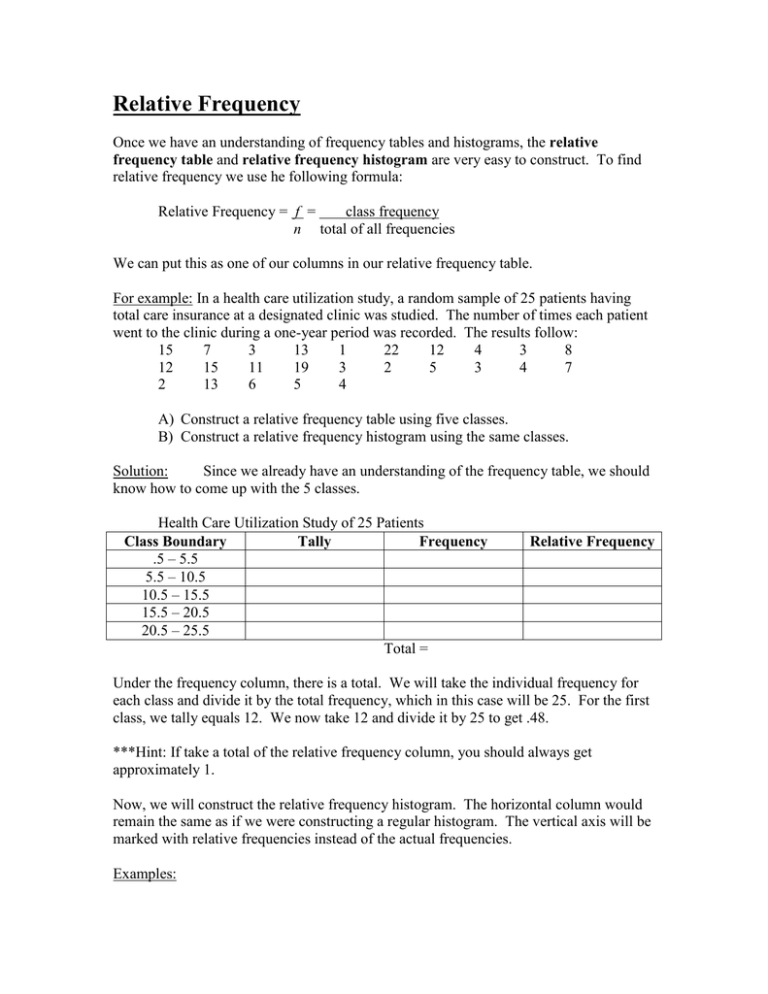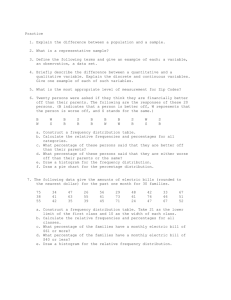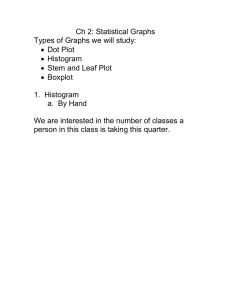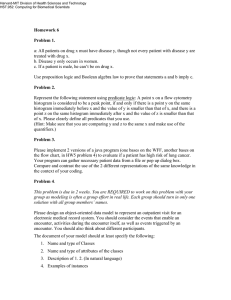Relative Frequency
advertisement

Relative Frequency Once we have an understanding of frequency tables and histograms, the relative frequency table and relative frequency histogram are very easy to construct. To find relative frequency we use he following formula: Relative Frequency = f = class frequency n total of all frequencies We can put this as one of our columns in our relative frequency table. For example: In a health care utilization study, a random sample of 25 patients having total care insurance at a designated clinic was studied. The number of times each patient went to the clinic during a one-year period was recorded. The results follow: 15 7 3 13 1 22 12 4 3 8 12 15 11 19 3 2 5 3 4 7 2 13 6 5 4 A) Construct a relative frequency table using five classes. B) Construct a relative frequency histogram using the same classes. Solution: Since we already have an understanding of the frequency table, we should know how to come up with the 5 classes. Health Care Utilization Study of 25 Patients Class Boundary Tally Frequency .5 – 5.5 5.5 – 10.5 10.5 – 15.5 15.5 – 20.5 20.5 – 25.5 Total = Relative Frequency Under the frequency column, there is a total. We will take the individual frequency for each class and divide it by the total frequency, which in this case will be 25. For the first class, we tally equals 12. We now take 12 and divide it by 25 to get .48. ***Hint: If take a total of the relative frequency column, you should always get approximately 1. Now, we will construct the relative frequency histogram. The horizontal column would remain the same as if we were constructing a regular histogram. The vertical axis will be marked with relative frequencies instead of the actual frequencies. Examples: 1) Home Video Incorporated rents out new releases. A random sample of 32 days gave the following information about the number of new releases rented each day at one of he local stores: 12 27 29 4 21 38 21 5 15 25 23 10 8 22 13 17 43 8 22 23 26 28 31 35 26 34 36 33 32 39 37 29 A) Construct a relative frequency table using 5 classes. B) Construct a relative frequency histogram. 2) The district manager of a suburban park and recreation area wants to estimate the amount of time people spend in their local park in July. A random sample of 50 local residents gave the following information on the estimated number of hours they spent in the regional park during the month of July: 8 5 9 12 15 18 2 3 5 4 2 8 6 10 13 14 8 10 9 13 21 2 4 3 7 7 6 7 6 16 19 11 3 3 8 4 11 10 9 8 6 6 6 7 8 12 6 7 20 7 A) Construct a relative frequency table using 7 classes. B) Construct a relative frequency histogram. 3) The American Association of Registered Dentists wants to estimate the number of fillings an adult (over 18 years of age) has accumulated. A random sample of 36 dental records gave the following information: 8 9 19 5 13 14 5 6 12 13 3 6 5 11 6 7 4 11 23 5 32 25 21 6 7 11 12 8 15 16 17 9 10 8 22 18 A) Construct a relative frequency table using 6 classes. B) Construct a relative frequency histogram. 4) A random sample 0f 42 auto insurance claims made on Any State Insurance Company gave the following information rounded to the nearest dollar: 705 800 1090 2408 2010 910 350 690 520 750 1000 860 170 1100 1150 1590 1841 1880 1942 2210 1886 1954 1710 1372 1200 1210 1351 1400 1790 1682 1310 1460 1550 1300 1463 1511 1190 1200 510 1285 1700 2350 A) Construct a relative frequency table using 8 classes. B) Construct a relative frequency histogram. 5) Nurses on the eight floor of Community Hospital believe they need extra staffing at night. To estimate the night workload, a random sample of 35 nights was used. For each night the total number of room calls to the nurses’ station on the eighth floor was recorded: 68 70 86 18 90 100 101 95 80 70 73 82 71 37 102 87 46 58 62 63 92 70 69 85 84 86 90 77 60 74 83 86 75 71 88 A) Construct a relative frequency table using 5 classes. B) Construct a relative frequency histogram.







